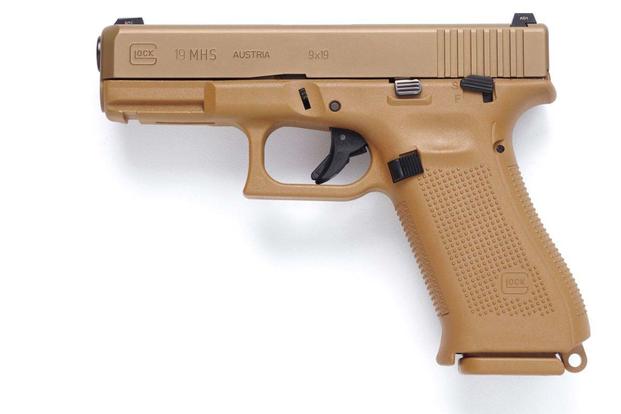The leadership at Glock Inc. says that the U.S. Army's decision to select Sig Sauer to make its new Modular Handgun System was driven by cost savings, not performance. The gun maker is also challenging the Army to complete the testing, which the service cut short, to see which gun performs better.
Two weeks have passed since the Government Accountability Office released the findings behind its decision to deny Glock Inc.'s protest of the Army's MHS decision.
Now Josh Dorsey, vice president of Glock Inc., said that Glock maintains that the Army's selection of Sig Sauer was based on "incomplete testing" and that Sig Sauer's bid was $102 million lower than Glock's.
"This is not about Glock. This is not about Sig. And it's not about the U.S. Army," Dorsey, a retired Marine, told Military.com. "It's about those that are on the ground, in harm's way."
It comes down to "the importance of a pistol, which doesn't sound like much unless you realize, if you pull a pistol in combat, you are in deep s***."
Dorsey maintains that the Army selected Sig Sauer as the winner of the MHS competition without conducting the "heavy endurance testing" that is common in military and federal small arms competitions.
Related content:
- Army Picks Sig Sauer's P320 Handgun to Replace M9 Service Pistol
- Dismissal of Bid Protest Clears Way for New Army Sidearm
- Army to Gunmakers: Show Us a New 7.62mm Service Rifle
Military.com reached out to both the Army and Sig Sauer for comment on this story, but the service did not respond by press time.
The Army awarded Sig Sauer a contract worth up to $580 million Jan. 19. Sig Sauer beat out Glock Inc., FN America and Beretta USA, maker of the current M9 9mm service pistol, in the competition for the Modular Handgun System program.
The 10-year agreement calls for Sig to supply the Army with full-size XM17 and compact XM18 versions of its 9mm pistol to replace the M9s and compact M11s in the inventory.
The service launched its long-awaited XM17 MHS competition in late August 2015 to replace its Cold War-era M9 9mm pistol. The decision formally ended the Beretta's 30-year hold on the Army's sidearm market.
From January to September 2016, the Army conducted what Dorsey calls initial, phase one testing and not "product verification testing described in the solicitation" which is the only way to determine which of the MHS entries meets the Army's requirements for safety, reliability and accuracy, according to Glock's legal argument to the GAO.
On August 29, 2016, the Army "established a competitive range consisting of the Glock 9mm one-gun proposal and the Sig Sauer 9mm two-gun proposal, according to the GAO's findings.
Dorsey argues that the GAO's description of "competitive range" means the both Glock's and Sig Sauer's submissions "are in fact pretty much the same."
But the GAO describes Sig Sauer 320 as having lower reliability than Glock 19 on page 11, footnote 13 of its findings.
"Under the factor 1 reliability evaluation, Sig Sauer's full-sized handgun had a higher stoppage rate than Glock's handgun, and there may have been other problems with the weapon's accuracy," GAO states.
To Dorsey, that "says it all."
"When you have stuff in the GAO report that says their stoppage rate is higher than ours -- that's a problem," Dorsey said.
Sig Sauer's $169.5 million bid outperformed Glock's $272.2 million bid, according to GAO, which made the Sig Sauer proposal the "best value to the government." The Army's initial announcement of the contract award to Sig Sauer described the deal as being worth up to $580 million, but the reason for the discrepancy is not clear.
"So one of the least important factors as they said in the RFP would be the price; that is what became the most important factor," Dorsey said.
"So let's think about that for a minute ... you are going to go forward making that decision now without completing the test on the two candidate systems that are in the competitive range? Does that make sense if it's your son or daughter sitting in that foxhole somewhere?"
Glock also argued that the Army's testing only went up to 12,500 rounds when the "service life of the selected pistol is specified to be 25,000 rounds," according to Glock's legal argument to GAO.
"We are not asking for them to overturn Sig," Dorsey said. "All we ask is for them to continue to test, so that the Army can be ensured that it has the best material solution for its soldiers. Make it fair, make it full and open; transparent and let's see where the chips fall.
"Fundamentally, Glock is going to continue to do what we always do. It is never over for us. It's always on those that go into harm's way and as long as they are in harm's way, we will continue to knock on doors and offer the best material solution to the handgun requirement because in my heart, I believe we do have the best material solution."
Matthew Cox can be reached at matthew.cox@military.com.






























